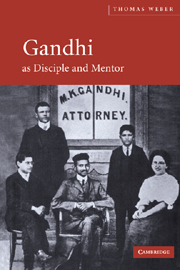Book contents
- Frontmatter
- Contents
- Notes
- Preface
- Glossary
- PART I INFLUENCE
- PART II GANDHI INFLUENCED
- PART III GANDHI'S INFLUENCE
- 8 The influential Gandhi
- 9 Arne Næss – the ecological movement finds depth
- 10 Johan Galtung – peace research moves beyond war
- 11 E. F. Schumacher – economics as if people mattered
- 12 Gene Sharp – nonviolence becomes a political method
- 13 The bottom of the hourglass: Gandhi's influence
- Bibliography
- Index
9 - Arne Næss – the ecological movement finds depth
Published online by Cambridge University Press: 22 September 2009
- Frontmatter
- Contents
- Notes
- Preface
- Glossary
- PART I INFLUENCE
- PART II GANDHI INFLUENCED
- PART III GANDHI'S INFLUENCE
- 8 The influential Gandhi
- 9 Arne Næss – the ecological movement finds depth
- 10 Johan Galtung – peace research moves beyond war
- 11 E. F. Schumacher – economics as if people mattered
- 12 Gene Sharp – nonviolence becomes a political method
- 13 The bottom of the hourglass: Gandhi's influence
- Bibliography
- Index
Summary
INTRODUCTION
Arne Næss was born in 1912 and at the age of twenty-seven was appointed to the Chair of Philosophy at the University of Oslo as the country's youngest professor, a job he held until 1969 when he retired to devote himself full-time to remedying the environmental problems he perceived. In between, he was part of the Norwegian resistance movement against Nazi occupation and took part in the first ascent of Tirich Mir, the highest peak (at 7,690 metres) in the Hindu Kush, as part of the Norwegian team in July 1950. The American academic philosopher and leading ecological thinker, George Sessions has stated that he is confident that when Næss' philosophical works are finally gathered together, ‘he will be recognised as a leading philosopher of the latter half of the twentieth century’, and more than this, ‘For his work in developing an ecological philosophy and paradigm, and by articulating and helping to launch the long-range deep ecology movement, he may well be recognized as one of the most important philosophers of the 20th century.’
Although a conservation ethic had been around for decades before the publication of books such as Rachel Carson's landmark Silent Spring and studies such as the Club of Rome's Limits to Growth, Arne Næss took environmental philosophy and activism into new areas with his call for a ‘deep ecology’. This concept has provided the framework for a wide variety of ecological movements from those of spiritual New Agers to radical tree spikers.
- Type
- Chapter
- Information
- Gandhi as Disciple and Mentor , pp. 191 - 202Publisher: Cambridge University PressPrint publication year: 2004

